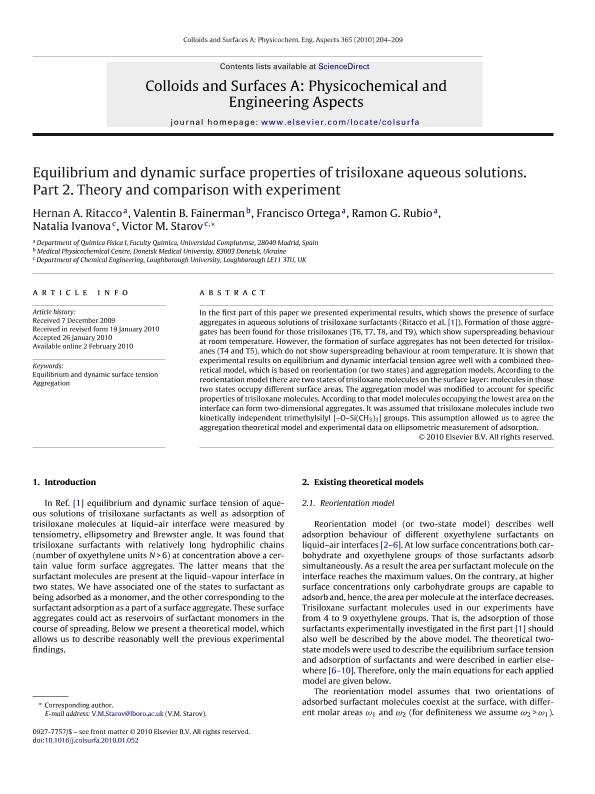Mostrar el registro sencillo del ítem
dc.contributor.author
Ritacco, Hernán Alejandro

dc.contributor.author
Fainerman, Valentin B.
dc.contributor.author
Ortega, Francisco
dc.contributor.author
Rubio, Ramon G.
dc.contributor.author
Ivanova, Natalia
dc.contributor.author
Starov, Victor M.
dc.date.available
2019-01-04T13:38:34Z
dc.date.issued
2010-12
dc.identifier.citation
Ritacco, Hernán Alejandro; Fainerman, Valentin B.; Ortega, Francisco; Rubio, Ramon G.; Ivanova, Natalia; et al.; Equilibrium and dynamic surface properties of trisiloxane aqueous solutions. Part 2. Theory and comparison with experiment; Elsevier Science; Colloids and Surfaces A: Physicochemical and Engineering Aspects; 365; 1-3; 12-2010; 204-209
dc.identifier.issn
0927-7757
dc.identifier.uri
http://hdl.handle.net/11336/67381
dc.description.abstract
In the first part of this paper we presented experimental results, which shows the presence of surface aggregates in aqueous solutions of trisiloxane surfactants (Ritacco et al. [1]). Formation of those aggregates has been found for those trisiloxanes (T6, T7, T8, and T9), which show superspreading behaviour at room temperature. However, the formation of surface aggregates has not been detected for trisiloxanes (T4 and T5), which do not show superspreading behaviour at room temperature. It is shown that experimental results on equilibrium and dynamic interfacial tension agree well with a combined theoretical model, which is based on reorientation (or two states) and aggregation models. According to the reorientation model there are two states of trisiloxane molecules on the surface layer: molecules in those two states occupy different surface areas. The aggregation model was modified to account for specific properties of trisiloxane molecules. According to that model molecules occupying the lowest area on the interface can form two-dimensional aggregates. It was assumed that trisiloxane molecules include two kinetically independent trimethylsilyl [-O-Si(CH3)3] groups. This assumption allowed us to agree the aggregation theoretical model and experimental data on ellipsometric measurement of adsorption. © 2010 Elsevier B.V.
dc.format
application/pdf
dc.language.iso
eng
dc.publisher
Elsevier Science

dc.rights
info:eu-repo/semantics/openAccess
dc.rights.uri
https://creativecommons.org/licenses/by-nc-sa/2.5/ar/
dc.subject
Aggregation
dc.subject
Equilibrium And Dynamic Surface Tension
dc.subject.classification
Otras Ciencias Químicas

dc.subject.classification
Ciencias Químicas

dc.subject.classification
CIENCIAS NATURALES Y EXACTAS

dc.title
Equilibrium and dynamic surface properties of trisiloxane aqueous solutions. Part 2. Theory and comparison with experiment
dc.type
info:eu-repo/semantics/article
dc.type
info:ar-repo/semantics/artículo
dc.type
info:eu-repo/semantics/publishedVersion
dc.date.updated
2019-01-02T18:23:23Z
dc.journal.volume
365
dc.journal.number
1-3
dc.journal.pagination
204-209
dc.journal.pais
Países Bajos

dc.journal.ciudad
Amsterdam
dc.description.fil
Fil: Ritacco, Hernán Alejandro. Universidad Complutense de Madrid; España
dc.description.fil
Fil: Fainerman, Valentin B.. Donetsk Medical University; Ucrania
dc.description.fil
Fil: Ortega, Francisco. Universidad Complutense de Madrid; España
dc.description.fil
Fil: Rubio, Ramon G.. Universidad Complutense de Madrid; España
dc.description.fil
Fil: Ivanova, Natalia. Loughborough University; Reino Unido
dc.description.fil
Fil: Starov, Victor M.. Loughborough University; Reino Unido
dc.journal.title
Colloids and Surfaces A: Physicochemical and Engineering Aspects

dc.relation.alternativeid
info:eu-repo/semantics/altIdentifier/url/https://www.sciencedirect.com/science/article/pii/S0927775710000762
dc.relation.alternativeid
info:eu-repo/semantics/altIdentifier/doi/https://doi.org/10.1016/j.colsurfa.2010.01.052
Archivos asociados
